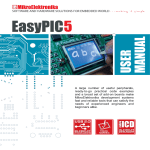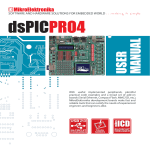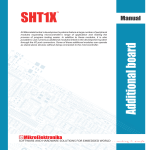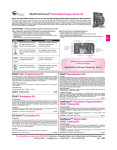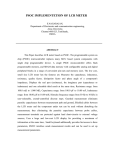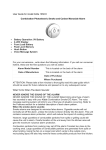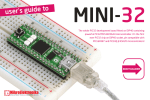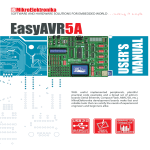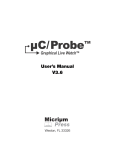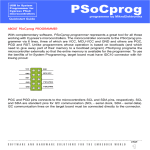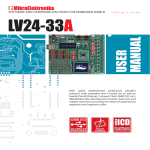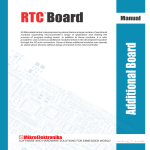Download EasyPSoC4 User Manual
Transcript
CONTENTS Easy PSoC4 KEY FEATURES CONNECTING THE SYSTEM INTRODUCTION 4 5 6 Switches and Jumpers MCU Sockets Power Supply On-board USB 2.0 Programmer RS-232 Communication RS-485 Communication Real Time Clock CAN-SPI DS1820 Digital Thermometer LEDs Push-Buttons 2x16 Character LCD Graphic LCD Touch Panel A/D Converter Test Inputs Direct Port Access MMC/SD (multimedia card) 7 8 10 11 12 13 14 15 16 17 18 19 20 21 22 23 24 4 EASY PSOC4 KEY FEATURES 1. External power supply 8v- 16v AC/DC; 2. On-board USB 2.0 programmer circuit; 13. MCU socket for additional MCU cards; 14. DIP switch SW1 to SW4 used for enabling/disabling on 3. 4. 5. 6. 7. 8. 9. 10. 11. 15. 16. 17. 18. 19. 20. 21. 22. RS-232 communication circuit; RS-485 communication circuit; Real time clock circuit; CAN-SPI circuit (Controller Area Network); DS1820 temperature sensor circuit; LCD 2x16 connector; LCD contrast potentiometer; A/D converter test inputs; 48-pin PSOC card with SMD CY8C27643-24PVXI chip; 12. MCU sockets; board components; Direct port access; LEDs showing logical states of MCU pins; Reset push button; Push buttons; GLCD connector; Touch panel connector; GLCD contrast potentiometer; Touch panel controller; and 23. MMC/SD multimedia card slot. Apart from this manual, the development system box contains development system, product CD, USB cable, RS232 cable and Installing USB drivers manual. In order to use the Easy PSoC4 properly, it is necessary to go through the following steps: Step no.1 Take the development system and product CD out of the box. Insert the product CD into CD drive. Please, do not connect the development system to a PC yet. Step no.2 Install PSoC flash programmer software to enable a program to be transferred from PC to the microcontroller chip. Step no.3 Install USB drivers on your PC to enable programmer's hardware to operate properly on the Easy PSoC4 board. For detailed installation instructions refer to the Installing USB drivers manual. Step no.4 Connect the Easy PSoC4 to PC using USB cable. Please use one of the USB ports on the back of the PC as they are directly connected to the computer motherboard. If you turn ON the power supply switch on the Easy PSoC4 board for the very first time, your PC will automatically detect a new hardware. You will be immediately prompted whether Windows should search for new drivers update or not. Select the option No, not this time and click Next. Another window appears, click Next and the operating system will automatically find the drivers. Click Finish to complete this process and run PSoCflash. After these four steps, your Easy PSoC4 is successfully installed and ready for use. You can read a program from the chip or write another one into it. The product CD provides numerous simple program examples to make your first steps Easy... 5 CONNECTING THE SYSTEM CONNECTING THE SYSTEM INTRODUCTION 6 INTRODUCTION The Easy PSoC4 is a full-featured development system for Cypress PSoC microcontrollers. It is designed to allow students and engineers to easily test and explore the capabilities of PSoC microcontrollers. It also allows PSoC microcontrollers to be interfaced with external circuits and a broad range of peripheral devices. The user can therefore concentrate on software development only. Figure 1 illustrates the development system. There are identification marks next to each component on a silkscreen, both on the top and bottom. These marks describe connection to the microcontroller, operation modes and provide additional useful information so that there is almost no need for additional schematics. Figure 1 Easy PSoC4 development system SWITCHES The Easy PSoC4 development system features a number of peripheral devices. In order to enable them before programming, the appropriate jumpers or switches have to be properly set. Switches are mechanical devices used to establish or break connection between two contacts. The Easy PSoC4 development system has four groups of switches. Figure 2 DIP switch DIP switch DIP switch DIP switch SW1 SW2 SW3 SW4 Switch group SW4 Switches 1, 2, 3 and 4 are ON, whereas 5, 6, 7 and 8 are OFF is used to enable/disable RS-232, RS-485 and MMC-CS; is used to enable/disable DS1820, CAN and SPI; enable/disable I2C, RTC-INT and touch panel controller; and enable/disable LEDs. JUMPERS Similarly, jumpers are used to break or establish connection between two points. Under the plastic cover of a jumper, there is a metal contact which establishes connection when a jumper is placed over two pins. Jumper is commonly used as a selector between two possible connections via 3-pin connector. As illustrated in Figure 3, the middle connector pin can be connected to the left or right pin, depending on the jumper’s position. Jumper is not placed and middle pin is unconnected. Figure 3 Jumper as a selector Jumper is placed on the right side connecting middle and right pin. Jumper is placed on the left side connecting middle and left pin. SWITCHES AND JUMPERS 7 MCU SOCKETS 8 MCU SOCKETS The Easy PSoC4 comes with a 48-pin CY8C27643-24P microcontroller soldered on MCU card that fits in DIP48 socket. The user can remove this card and insert another one in DIP48, DIP28, DIP20 or DIP8 packages with adequate pin-out. Wide MCU cards on which you can solder microcontrollers in QFN, TQFP, SOIC and SSOP packages can be used as well. Figure 4 MCU sockets Easy PSoC MCU cards are used for microcontrollers having no appropriate on-board DIP socket. For large number of pins these microcontrollers have, they should be soldered on an MCU card and placed in DIMM socket. The advantage of the cards is that they can be used for connecting microcontrollers in different packages using only one on-board socket. Note: Since all packages have parallel connections, there must not be more than one microcontroller on the board at a time. All ports are connected to LEDs and push-buttons, which allows you to easily test and monitor digital pins state. Some of the pins are connected to on-board peripherals such as DS1820 temperature sensor, RS232 communication module, RS-485 communication module, LCD, etc. Figure 5 System connection 9 MCU SOCKETS The microcontroller pins are routed to various peripherals as illustrated in Figure 5. All MCU ports are directly connected to Direct Port Access 2x5(10-pin) connectors. These are normally used for connecting external peripherals to the board, as well as points for digital logic probe connecting. POWER SUPPLY 10 POWER SUPPLY The Easy PSoC4 can use one out of two power supply sources - PC power supply over USB cable (by default) or external power supply (external AC/DC power adapter). When using power supply over USB cable, jumper J1 should be set in the right-hand position. When using external power supply, the Easy PSoC4 board produces +5V using LM7805 voltage regulator. The external power supply can be AC or DC, while its voltage ranges between 8 and 16V. In this case, jumper J1 should be set in the left-hand position. Figure 7 illustrates USB and external power supply circuit diagram. Figure 6 Figure 7 Power supply Power supply circuit diagram J1 in the left-hand position: system is powered from the external AC/DC power adapter. J1 in the right-hand position: system is powered from PC over USB cable. ON-BOARD USB 2.0 PROGRAMMER There is no need to use external equipment during programming as the Easy PSoC4 development system has its own on-board USB 2.0 programmer. All you need to do is to connect the system to PC using the USB cable. Load your program into the microcontroller via the PSoCflash programming software supplied with the Easy PSoC4. Figure 8 Figure 9 Note: USB 2.0 programmer USB 2.0 programmer circuit diagram There is no need to reset MCU after programming because it will be automatically reset the MCU automatically. ON-BOARD USB 2.0 PROGRAMMER 11 RS-232 COMMUNICATION 12 RS-232 COMMUNICATION RS-232 communication module enables point-to-point data transfer. It is commonly used in data acquisition applications to transfer data between the microcontroller and PC. Since the voltage levels of the microcontroller and PC are not directly compatible with each other, a level converter, such as MAX232, must be used. In order to provide more flexible system, the microcontroller is connected to the MAX232 via first four switches of the DIP switch SW1. The first and third switch are used to connect Rx and Tx lines with P0[0] and P0[1] pins, while the second and fourth switch are used to connect these lines with P0[6] and P0[7] pins. Figure 10 RS-232 communication Figure 11 RS-232 communication circuit diagram RS-485 COMMUNICATION Similarly, RS-485 communication module is commonly used for data transfer between several microcontrollers. ADM485 interface transceiver is used for transforming signal from microcontroller’s Rx and Tx lines in to a differential signal on “+” and “-” output lines. Figure 12 RS-485 communication The Easy PSoC4 development system has one RS-485 communication device. In order to provide more flexible system, the microcontroller is connected to the ADM485 via three switches (5, 6 and 7) of the DIP switch SW1. These switches are used to connect Rt, Rx, and Tx microcontroller lines to RS-485. Figure 13 RS-485 communication circuit diagram RS-485 COMMUNICATION 13 REAL TIME CLOCK (RTC) 14 REAL TIME CLOCK (RTC) Most hardware projects need a real time clock or delay source. For this reason the Easy PSoC4 development system is provided with the PCF8583P chip (clock/calendar with 240x8-bit RAM). It uses I2C serial communication to exchange data with the microcontroller. Besides, it has one interrupt output. In order that PCF8583P works properly, both interrupt and I2C communication lines must be connected to the microcontroller using switches 1, 2 and 3 of the DIP switch SW3. Figure 14 Real time clock Figure 15 Real time clock circuit diagram CAN-SPI 15 CAN-SPI CAN (Controller Area Network) is a serial network initially designed for the use in automotive industry, but has also become a very popular bus in industrial automation and other applications as well. CAN is a network established among microcontrollers. It is a two-wire, half-duplex, highspeed network system. Half-duplex means that the microcontroller can send and receive data, but either operation at a time. The Easy PSoC4 development system has one CAN communication device. Microcontroller is connected to CAN controller through SPI communication, so you just need to turn on the appropriate switches of the DIP switch SW2 (3, 4, 5, 7 and 8). Figure 16 CAN-SPI Figure 17 CAN-SPI circuit diagram DS1820 DIGITAL THERMOMETER 16 DS1820 DIGITAL THERMOMETER The DS1820 digital thermometer is convenient for environmental temperature measurement. It can measure temperature in the range between -55Co and 125Co with +/-0.5Co accuracy. It must be properly placed in the 3-pin socket provided on the Easy PSoC4, as marked on the board (see Figure 19). Otherwise, the DS1820 could be permanently damaged. DS1820 socket Figure 18 DS1820 digital thermometer Figure 19 DS1820 digital thermometer circuit diagram LEDs 17 LEDS Light Emitting Diode (LEDs) are components used for displaying pin digital state. The EasyPSoC4 has 64 LEDs connected to the microcontroller ports: PORT0, PORT1, PORT2, PORT3, PORT4, PORT5, PORT6 and PORT7. LEDs can be enable/disable using the appropriate switch of the DIP switch SW4 depending on port you want to use. Figure 20 LEDs Figure 21 LEDs circuit diagram PUSH BUTTONS The Easy PSoC4 has 64 push buttons which can be used to change states of digital inputs on the microcontroller ports. There is also one red pushbutton that acts as a RESET. PUSH BUTTONS 18 Figure 23 illustrates connection between push buttons and PORT0 and PORT1 as well as reset button connection. There are six more ports not shown on this circuit diagram, but connected to push buttons in the same way as PORT0 and PORT1. Figure 22 Push buttons Figure 23 Push buttons circuit diagram 2X16 CHARACTER LCD A standard character LCD is probably the most widely used data visualization component. It usually displays messages in two lines, containing up to 16 alphanumeric characters each. The character LCD communicates with the microcontroller via 4-bit data bus. Figure 25 illustrates its connection to the microcontroller. Figure 24 2x16 LCD in 4-bit mode Figure 25 2x16 LCD circuit diagram Note: Have in mind that LCD should be placed or removed from the Easy PSoC4A only after the power supply is turned off. Otherwise, it could be permanently damaged. 2X16 CHARACTER LCD 19 GRAPHIC LCD 20 GRAPHIC LCD A graphic LCD (GLCD) provides an advanced method for displaying visual messages. While a character LCD can display only alphanumeric characters, a GLCD can be used to display messages in the form of drawings and bitmaps. The most commonly used graphic LCD has the screen resolution of 128x64 pixels. The GLCD contrast can be adjusted using the potentiometer P4 placed next to GLCD. Figure 27 GLCD Figure 26 GLCD contrast adjustment potentiometer Figure 28 GLCD circuit diagram Note: Have in mind that GLCD should be placed or removed from the Easy PSoC4 development system only after the power supply is turned off. Otherwise, it could be permanently damaged. TOUCH PANEL 21 TOUCH PANEL Touch panel is a thin self-adhesive, transparent panel that could be placed over the screen of graphic LCD. It consists of two separate foils which form a “sandwich” structure. It is very sensitive to press so that even a soft touch causes some changes on the output signal. It is used in various user-friendly devices in combination with graphic LCD. Connector CN4 enables this device to be connected to on-board touch panel controller the active part of which consists of 5 discrete transistors. Four switches of the DIP switch SW3 enable or disable connection between this controller and P0[2], P0[3], P3[4] and P3[4] pins. Figure 29 Touch panel Figure 30 Touch panel controller Figure 31 Touch panel circuit diagram A/D CONVERTER TEST INPUTS 22 A/D CONVERTER TEST INPUTS A/D conversion has a wide range of applications. The microcontroller takes an analog signal from its input pin and converts it into a digital value. Basically, it is possible to measure any analog signal that fits in the range acceptable by the microcontroller. As for the Easy PSoC4, this range is between 0 and 5V. The Easy PSoC4 development system has three potentiometer used to adjust the level of analog signals in order to test the operation of analog-to-digital converter (ADC). The potentiometer outputs have voltage in the range of 0-5V. These analog signals can be connected to three different analog input pins simultaneously. Jumper groups J3, J4 and J5 are used for connecting potentiometer P1, P2 and P3 to the appropriate MCU pins. Figure 32 A/D converter test inputs Figure 33 A/D converter test inputs circuit diagram DIRECT PORT ACCESS CONNECTORS All microcontroller input/output pins can be accessed via IDC10 connectors (2x5) placed along the right side of the board. For each microcontroller port there is one connector providing up to eight port pins and two additional pins connected to VCC and GND. Figure 35 Direct port access flat cable connection Figure 34 Direct port access These connectors can be used to connect the system to external peripherals such as Serial Ethernet, Compact Flash, MMC/SD, ADC, DAC, CAN, RTC, RS-485 etc. If onboard and external peripherals use the same pins then on-board peripherals must be disconnected from the microcontroller by setting the appropriate jumpers. The connectors can also be used for attaching logic probes or other test equipment. Figure 36 Direct port access circuit diagram DIRECT PORT ACCESS CONNECTORS 23 MULTIMEDIA CARD (MMC/SD) 24 MULTIMEDIA CARD (MMC/SD) MMC card is used as a data storage media for portable devices. With MMC reader you can easily transfer data from MMC card to your PC. The microcontroller placed on the Easy PSoC4 communicates with Multi Media Card via SPI communication. Figure 37 MMC/SD (multimedia card) To enable MMC card it is necessary to turn on switch 8 of the DIP switch SW1 and switches 6, 7 and 8 of the DIP switch SW2. In this way, MMC Chip Select line (MMC-CS) and SPI communication lines (SCK, MISO and MOSI) are connected with the microcontroller. The operating voltage of the Easy PSoC4 is 5V DC, whereas that of MMC card is 3.3V DC. For this reason, there is an onboard voltage regulator provided with MMC card (MC33269DT-3.3). Data lines connecting the microcontroller and MMC card must also be adjusted to 3.3V It is done using resistor voltage dividers shown in Figure 38. MULTIMEDIA CARD (MMC/SD) 25 Figure 38 MMC/SD (multimedia card) circuit diagram EasyPSoC4 Expand your development system with our extra boards: Package content: Development system: CD: Cables: Documentation: EasyPSoC4 with CY8C27643-24P included mikroE product CD with software USB and RS-232 cable User manual for EasyPSoC4, driver installation guide Installing USB drivers System specifications: USB programmer: Power supply: Power consumption: Size: Weight: mikroBuffer Board USB type B External AC/DC 8-16V PC over USB cable (5V DC) >100mA (depends on connected peripherals) 25 x 21cm (9,8 x 8,2 inch) 393g (0.866 lbs) MikroDRIVE board Empty MCU cards MCU cards with soldered microcontroller ... and many others. Please, visit our website: www.mikroe.com




























